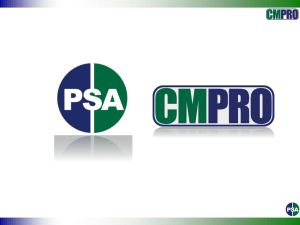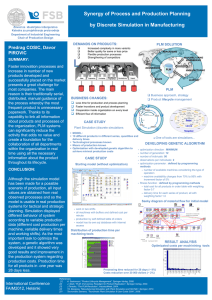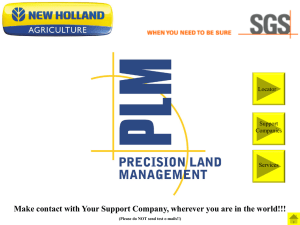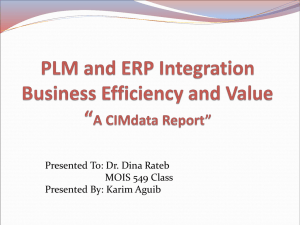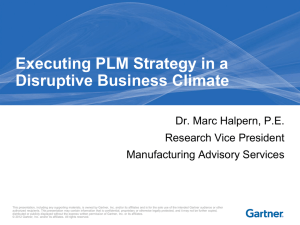Driving Innovation from the Top Floor to the Shop Floor
advertisement
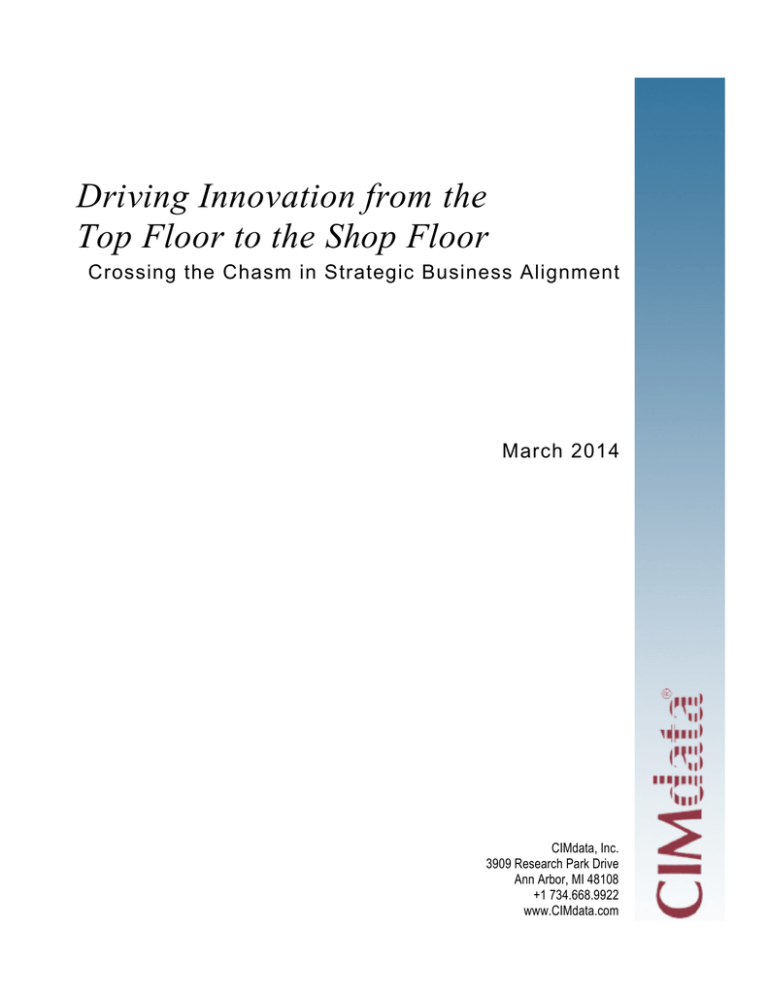
Driving Innovation from the Top Floor to the Shop Floor Crossing the Chasm in Strategic Business Alignment March 2014 CIMdata, Inc. 3909 Research Park Drive Ann Arbor, MI 48108 +1 734.668.9922 www.CIMdata.com Driving Innovation from the Top Floor to the Shop Floor Crossing the Chasm in Strategic Business Alignment Driving Innovation from the Top Floor to the Shop Floor Companies thrive on innovation, but how do they assess and plan their actions to meet corporate strategic objectives? Enterprise innovation management (EIM) solutions are helping global companies bridge the chasm between corporate strategy and purposeful action across a wide spectrum of business operations. EIM helps strategically define necessary product and process innovation, including product development actions executed through product lifecycle management (PLM), and other enterprise strategies. EIM and PLM working together can help ensure that product innovation meets both corporate strategic objectives and lifecycle requirements. Why and How this Matters for Your Business According to conventional wisdom, companies thrive on innovation. Common practice is to use a strategic planning process to go from vision to mission to strategy. Depending on the industry, the approach necessary to meet strategic innovation objectives will vary. The focus could be new products, services, or processes; or a combination of strategic initiatives, with returns projected for each alternative under consideration. But how do companies assess and plan their actions to meet corporate strategic objectives? Which initiatives in product, services, processes, or infrastructure enhancements should be approved? How do they balance portfolio and project investments between line extensions, newto-the-market products, and risky ventures? The most commonly used tools are pen and paper, office automation tools, sticky notes, and other manual processes that can drain resources to create and maintain, and provide little visibility into the alignment with strategy. A new class of offering, termed enterprise innovation management (EIM), has emerged to support these strategic processes. CIMdata tracks these EIM firms as part of our broad PLM definition, and Sopheon1 is a longtime leader in this market space. Their Accolade solution is purpose-built to address the issues mentioned above, and is being used by global leaders in many industries to empower teams to reach (and often exceed) innovation objectives. EIM helps strategically define the necessary product and process innovation, including product development actions that are then executed through product lifecycle management (PLM) and other enterprise processes. Working together, EIM and PLM can help ensure that product innovation meets both corporate strategic objectives and lifecycle requirements. Research for this paper was partially supported by Sopheon. 1 http://www.sopheon.com/ Copyright © 2014 by CIMdata, Inc. 1 Driving Innovation from the Top Floor to the Shop Floor Crossing the Chasm in Strategic Business Alignment Connecting Strategy and Innovation Innovation is central to the strategy of many companies. This is supported by a wide range of studies and experts. For example, IBM’s recent CEO study of over 1,700 CEOs in 64 countries found that over half saw innovation as key to their success.2 Both product and process innovation were seen as essential. A recent search on amazon.com revealed over 63,000 titles available to help readers innovate. Innovators have an advantage, but also face dilemmas, according to well-known business author Clayton Christenson3. If you need to innovate, going “open,” or crowdsourcing, are the trendy choices. Has your choice reached the tipping point or crossed the chasm? While the numerous authors mentioned above often have significant expertise and can offer pithy insights, many offer tactics and processes that can at best help you bring new information or intellectual property into your organization. That’s all good to know, but how do you actually implement effective innovation processes and practices in your organization, and how do you determine what and where to innovate? If open innovation is your chosen path, what are you trying to achieve? How do you actually make the right things happen? Ideally, your company makes these decisions using a strategic planning process, as illustrated in Figure 1. This process is conducted in an organizational context, and requires collaboration across a wide range of stakeholders. The company vision should be forward looking, describing an idealized world and the company’s place in it. The mission statement should focus on the fundamental Figure 1—The Organizational Context of Portfolio Management Source: The Project Management Institute (PMI) 2 3 Leading Through Connections: Insights from the Global CEO Study. IBM Institute for Business Value. May 2012. http://www.ibm.com. There is no direct link to the paper, you have to find it and register. Christensen, Clayton M. The Innovator’s Dilemma. Cambridge, MA. Harvard Business School Press. 1997 Copyright © 2014 by CIMdata, Inc. 2 Ideally, your company makes these decisions using a strategic planning process… The company vision should be forward looking… The mission statement should focus on the fundamental purpose of the organization. Driving Innovation from the Top Floor to the Shop Floor Crossing the Chasm in Strategic Business Alignment purpose of the organization, and how it plans to reach the vision. The organizational strategy and objectives are more definitive, setting the actions needed to fulfill the stated mission. When the pieces are laid out like this, aligning innovation and strategy sounds simple. This is also true of many concepts described in business books on innovation. They make sense when you read them, but putting concepts into practice is difficult. It is hard work defining the company’s vision and mission; they need to be realistic while making the organization stretch to reach them. What these books can provide is a set of planning processes to help shape strategy and get buy-in from the key stakeholders inside and outside of the organization. But a large problem still remains: It is one thing for a company to decide that it will become the leading global provider of a product or service, but how do they accomplish that? For most companies, doing more of the same is not an option. Strategists have to determine the right mix of new and old, but what is it? There is a gap between an organization’s aspirations to execute a given strategy and its making the right decisions to do so. Once a company decides on a set of actions, there are many enterprise strategies and systems to help “manage on-going operations” and “manage authorized programs and projects,” as shown in Figure 1. For example, on the left side of the figure, companies use enterprise resource planning (ERP) to optimally allocate resources for production. Customer relationship management (CRM) solutions do just that, i.e., they help companies engage with their customers to manage the sales and provisioning of products and services. Companies must be able to innovate across the spectrum of their operations, including logistics, infrastructure, processes, services, and specific strategic initiatives. In some cases new business models may be needed to best capture the market for a new innovation. Once the necessary innovation is defined from a business sense, different types of enterprise software help support executing these innovation efforts, like ERP or CRM. The right side of Figure 1 focuses on executing programs and projects to conceive and design products and services. The acronym PPM is somewhat overloaded in the enterprise software market, with different providers focusing on programs, products, portfolios, and projects for the Ps. Most of these offerings are implemented to roll up execution data from programs and projects to support management oversight and action, not to help determine what gets into a portfolio. PLM strategies and enabling solutions help companies manage the authorized programs and projects in product and service development. CIMdata defines PLM as a strategic business approach that applies a consistent set of business solutions in support of the collaborative creation, management, dissemination, and use of product definition information across the extended enterprise. Product companies turn to PLM strategies and solutions to get products developed according to requirements and established engineering and materials specifications. But how did the management team determine the right products to develop according business strategy and portfolio priorities? This requires Copyright © 2014 by CIMdata, Inc. 3 Most [PPM] offerings are implemented to roll up execution data from programs and projects to support management oversight and action, not in helping to determine what gets into a portfolio. …how did the management team determine the right products to develop according business strategy and portfolio priorities? Driving Innovation from the Top Floor to the Shop Floor Crossing the Chasm in Strategic Business Alignment strong, two-way connections between organization strategy and objectives and their execution in the bottom layers of Figure 1. Based on the results of a recent global study by Frost & Sullivan4, this is an alltoo-common problem. Companies around the world still struggle to determine what to execute. Their research identified five challenges faced by companies in shaping their R&D, innovation, and product development strategies: Companies around the world still struggle to determine what to execute. • Generating an accurate and relevant technology roadmap • Prioritizing innovation ideas and projects • Identifying breakthrough new-product ideas • Finding viable new applications for existing products and capabilities • Embedding the voice of the customer in the innovation process Enterprise Innovation Management While some believe portfolio management offerings can address these issues, in most cases those offerings are about rolling up information from execution, not supporting the necessary top-down strategic decision making. Compared to some other work processes, these processes are under-tooled, and are executed on paper or using office automation tools, sticky notes, and other manual approaches. Enterprise innovation management has emerged to support these strategic processes. CIMdata tracks EIM firms as part of our broad PLM definition. These solutions, and the processes they support, are an essential connection between corporate strategy, innovation, and execution across the full spectrum of companies’ strategy and operations. Sopheon is a long-time leader in this market space (www.Sopheon.com). Their Accolade offering is currently helping companies in a range of industries address the problems raised above. Many Sopheon customers are global leaders in their markets, and are using Accolade to identify the best options for a wide range of product, process, and business innovation activities. This can include innovation efforts in logistics and infrastructure, and sales processes and methods. New business opportunities may require new business models, which may need trial and testing before they are fully adopted. Sopheon has experience supporting a broad range of organizational innovation strategies. By connecting strategy, innovation, and execution, Accolade is helping leading global companies cross the chasm between corporate strategy and purposeful action. A new class of offerings, termed enterprise innovation management (EIM), has emerged to support these strategic processes. How do they bridge that gap? Sopheon has integrated Accolade into a wide range of enterprise systems that support both sides of the organization as shown in Figure 1. Each domain has its own data and process management solution, and Accolade can share data that helps define actions in those domains, like costs, revenue estimates, timing, capital expenditures, or other business information. Accolade supports processes that define the optimal mix of innovation activities, and initiates innovation projects. Accolade can help companies strategically define the necessary product and process innovation By connecting strategy, innovation, and execution, Accolade is helping leading global companies cross the chasm between corporate strategy and purposeful action. 4 R&D/Innovation and Product Development Priorities. 2013 Global Survey Results. Frost & Sullivan. Copyright © 2014 by CIMdata, Inc. 4 Sopheon is a long-time leader in this market space…Many Sopheon customers are global leaders in their markets. Driving Innovation from the Top Floor to the Shop Floor Crossing the Chasm in Strategic Business Alignment actions. The data necessary to execute those actions is passed to the appropriate enterprise systems to manage the projects at the detailed level. For example, ERP and PLM integrations are common in Sopheon’s customer base. Accolade can manage the business layer, while PLM-enabling solutions can manage the technical development activities and deliverables. Working together, EIM and PLM can help ensure that product innovation meets both corporate strategic objectives and lifecycle requirements. The following sections provide some examples that illustrate the direct business benefits realized by a number of global companies working with Sopheon to implement innovation management solutions that address these problems. Technology Roadmapping Corning is a world leader in manufacturing specialty glass and ceramics, and their many achievements include collaboration with Thomas Edison on the first commercial light bulb. The company operates research centers in North America, Europe, and Asia. While they had a mature roadmapping process in place, it was supported by a collection of static documents that could not meet the dynamic requirements of their global business. The inability to quickly incorporate real-time information into the process led to one-off projects, reduced the possibility for synergies between groups, and lengthened time to market. Corning sought a solution that could support collaboration among R&D, product engineering, sales, marketing, manufacturing, and strategic planning on this key process. Corning sought a solution that could support collaboration between R&D, product engineering, sales, marketing, manufacturing, and strategic planning on this key process. To address this problem, Corning turned to Sopheon and their Accolade Vision Strategist™ offering (now known as Accolade Roadmapping™), which is designed to support market, product, and technology planning, including roadmapping. Corning was able to quickly adapt this tool to their existing process, creating a consistent set of information that could be kept up to date, and readily shared using a Web-based interface. Within 18 months, Corning was able to expand their planning horizon, greatly improving the effectiveness of their planning and execution, and reducing time to market. According to Bruce Kirk, Corning’s Director of Corporate Innovation Effectiveness, “With Vision Strategist, we now have more visibility into our pipeline. Most users are able to forecast three-to-five years out into the future, compared to the one-year period from before…. Roadmaps are fundamental in helping us prepare a timely and effective response to potential market events.” “With Vision Strategist, we now have more visibility into our pipeline. Most users are able to forecast three-to-five years out into the future, compared to the one year period from before.” Prioritizing Ideas and Projects BASF, a global leader in the chemical industry, has a straightforward corporate purpose: “We create chemistry for a sustainable future.” A company of its size, with 2012 revenues of nearly $101 billion, must constantly look to new products to grow. Unfortunately, each division and business unit had their own product innovation process. This made it very difficult to prioritize ideas and projects across their far-flung operations. BASF believed they were behind the Copyright © 2014 by CIMdata, Inc. 5 Driving Innovation from the Top Floor to the Shop Floor Crossing the Chasm in Strategic Business Alignment competition in this area, and looked for a user-friendly system to provide more transparency in research planning supported by powerful reporting tools. BASF selected Accolade in 2003, and used the Process Manager module to implement a standard Stage-Gate® process across the company. Within 12 months they had over 2,200 users, supporting over 3,300 projects. “Our goal is to translate market trends and ideas from the scientific community into tangible innovations for our customers,” claims Manfred Hauptreif, Manager of Science Relations & Innovation Management at BASF. “Accolade provides us with a flexible backbone for managing our innovation projects, and it allows our senior management to have complete visibility of the projects in our innovation portfolio. Now we can prioritize our work more effectively and get our best new products to market faster.” Interestingly, their commitment to a common solution and process has also helped them to quickly integrate their many acquisitions into one product and process innovation network. “BASF’s goal is to translate market trends and ideas from the scientific community into tangible innovations for our customers… Now we can prioritize our work more effectively and get our best new products to market faster.” Finding New Applications According to the Parker Hannifin Corporation, a diversified manufacturer of motion and control technologies and systems, their products can be found “on or around anything that moves.” Parker does mean anywhere, with their products delivered to over 100 countries. A global company with $13 billion in revenues, Parker has to manage innovation across 139 different business units. Like many manufacturing companies with large product portfolios, Parker has to achieve the right balance between finding both new applications for existing products, and more value-added products and systems for their portfolio. In fact, they found that line extensions and enhancements were consuming a disproportionate share of their new-product development resources. Projects were not being killed, and there were too many duplicate projects across their many business units. While half of their growth historically came through acquisitions, their “Win Strategy” program dictated that each division had to produce organic growth of 4%-5%. Common processes and tools were one part of the answer. Parker is well known for their commitment to PLM, and considered several PLM offerings to support this need. In the end, however, Parker selected Sopheon because of their subject-matter expertise, and the ease of use and speed of deployment with the Accolade solution. Importantly, Parker sees Accolade as an important complement to PLM, providing synergies not possible using just one approach. Parker Hannifin has to achieve the right balance between finding both new applications for existing products, and more valueadded products and systems for their portfolio…They selected Sopheon because of their subject-matter expertise, and the ease of use and speed of deployment with the Accolade solution. With their commitment to a common process and tools, Parker has increased their revenue from new products from 6% of total revenue in Accolade is deployed across all Parker business units, enabling collaboration 2008 to 19% in 2012. across all seven Parker operating groups in 49 countries. “Parker’s goal, simply stated, is to increase revenue and profit from new products,” according to Craig Maxwell, Chief Innovation Officer at Parker. “The strategic blueprint for achieving that goal is in place, but its success depends upon having the right methodologies and tools to support implementation.” With their commitment to a common process and tools, Parker has increased their new product revenue from 6% of total revenue in 2008 to 19% in 2012. Parker is also using Sopheon’s Accolade Idea Lab™ solution to create communities of interest, and Copyright © 2014 by CIMdata, Inc. 6 Driving Innovation from the Top Floor to the Shop Floor Crossing the Chasm in Strategic Business Alignment to support global collaboration on campaigns for idea and concept development. In one notable case, a Parker division developed a new technology to pump nitrogen into potato chip bags to retain freshness. Through Idea Lab, one Parker division repurposed this technology to aid in pumping nitrogen into airplane fuel tanks, while another used it to pump nitrogen into automobile tires. Please join the conversation! CIMdata and Sopheon are collaborating on a survey to better understand how companies are crossing the chasm in strategic business alignment. For more information, please see http://www.CIMdata.com/innovation. Conclusion In today’s global economy, companies have no choice but to innovate, and to innovate more effectively. But what is the right set of tactical activities to execute to meet your strategic objectives? There is a gap between strategic planning and execution, a gap that has been shown to have both top- and bottom-line impacts. A recent study by Booz & Company found that companies whose innovation strategies clearly aligned with their business goals had significantly better business performance—over a five-year period, these companies had higher business value growth (33%) and profit growth (17%)— when compared with companies whose strategies and goals were misaligned5. When successful, this alignment brings more clarity on what mix of actions will help a company achieve its strategic goals. Once you decide what to execute, PLM, ERP, and a whole host of other enterprise strategies and solutions can help you do it. But how do you cross that chasm? How do you ensure that your strategies and business goals are in alignment? How do you truly drive innovation from the top floor to the shop floor? Enterprise innovation management solutions have emerged to supplement PLM and traditional PPM solutions to help support, capture, and then execute these types of strategic decision-making processes. Sopheon, a leading EIM solution provider and long-time member of the PLM Economy, is supporting a wide range of global market leaders to span this gap between strategy and execution. Customers like Corning, BASF, and Parker Hannifin illustrate how EIM crosses the chasm between corporate strategy and purposeful action. Sopheon’s Accolade suite provides the necessary connection between strategy and action, and is an important enabler for PLM and other enterprise strategies. Only by selecting the right strategic options AND executing them effectively can companies reach their strategic and market objectives. This approach can take a company from one that is teetering on the edge of the chasm, unsure of where to go, to one confidently bounding over the chasm to business success. Which kind of company do you want to be? 5 Booz & Company, http://www.booz.com/global/home/press/article/49852237, 18 February 2014. Copyright © 2014 by CIMdata, Inc. 7 Customers like Corning, BASF, and Parker Hannifin illustrate how EIM crosses the chasm between corporate strategy and purposeful action. Sopheon’s Accolade suite provides the necessary connection between strategy and action, and is an important enabler for PLM and other enterprise strategies. This approach can take a company from one that is teetering on the edge of the chasm, unsure of where to go, to one confidently bounding over the chasm to business success. Which kind of company do you want to be ? Driving Innovation from the Top Floor to the Shop Floor Crossing the Chasm in Strategic Business Alignment About CIMdata CIMdata, a leading independent worldwide firm, provides strategic management consulting to maximize an enterprise’s ability to design and deliver innovative products and services through the application of Product Lifecycle Management (PLM) solutions. Since its founding over thirty years ago, CIMdata has delivered world-class knowledge, expertise, and best-practice methods on PLM solutions. These solutions incorporate both business processes and a wideranging set of PLM-enabling technologies. CIMdata works with both industrial organizations and providers of technologies and services seeking competitive advantage in the global economy. CIMdata helps industrial organizations establish effective PLM strategies, assists in the identification of requirements and selection of PLM technologies, helps organizations optimize their operational structure and processes to implement solutions, and assists in the deployment of these solutions. For PLM solution providers, CIMdata helps define business and market strategies, delivers worldwide market information and analyses, provides education and support for internal sales and marketing teams, as well as overall support at all stages of business and product programs to make them optimally effective in their markets. In addition to consulting, CIMdata conducts research, provides PLM-focused subscription services, and produces several commercial publications. The company also provides industry education through PLM certification programs, seminars, and conferences worldwide. CIMdata serves clients around the world from offices in North America, Europe, and Asia-Pacific. To learn more about CIMdata’s services, visit our website at www.CIMdata.com or contact CIMdata at: 3909 Research Park Drive, Ann Arbor, MI 48108, USA. Tel: +1 734.668.9922. Fax: +1 734.668.1957; or at Oogststraat 20, 6004 CV Weert, The Netherlands. Tel: +31 (0) 495.533.666. This document is copyright 2014 by CIMdata, Inc. and is protected by U.S. and international copyright laws and conventions. This document may not be copied, reproduced, stored in a retrieval system, transmitted in any form, posted on a public or private website or bulletin board, or sublicensed to a third party without the written consent of CIMdata. No copyright may be obscured or removed from the paper. CIMdata® is a Registered Trademark of CIMdata, Inc. All trademarks and registered marks of products and companies referred to in this paper are protected. This document was developed on the basis of information and sources believed to be reliable. This document is to be used “as is.” CIMdata makes no guarantees or representations regarding, and shall have no liability for the accuracy of, data, subject matter, quality, or timeliness of the content. Copyright © 2014 by CIMdata, Inc. 8
